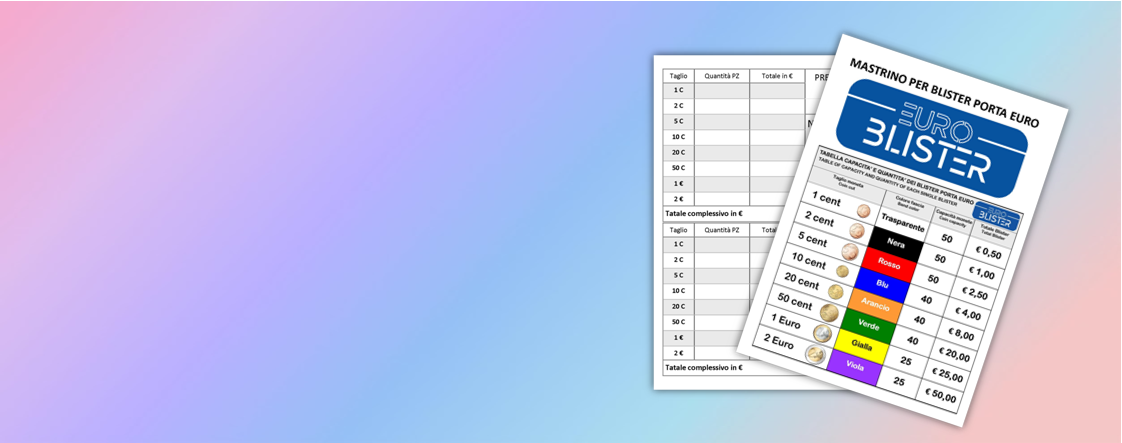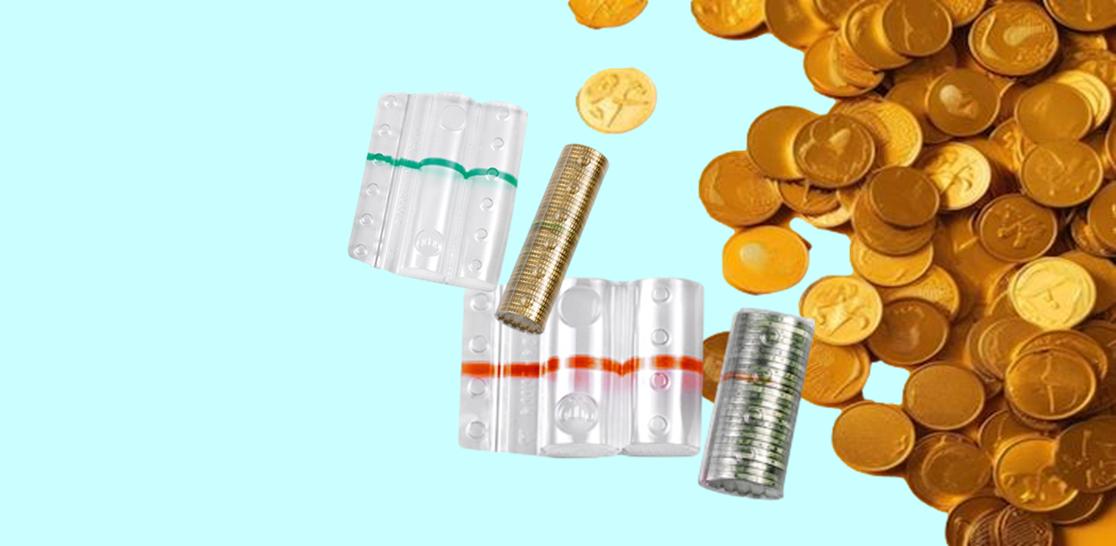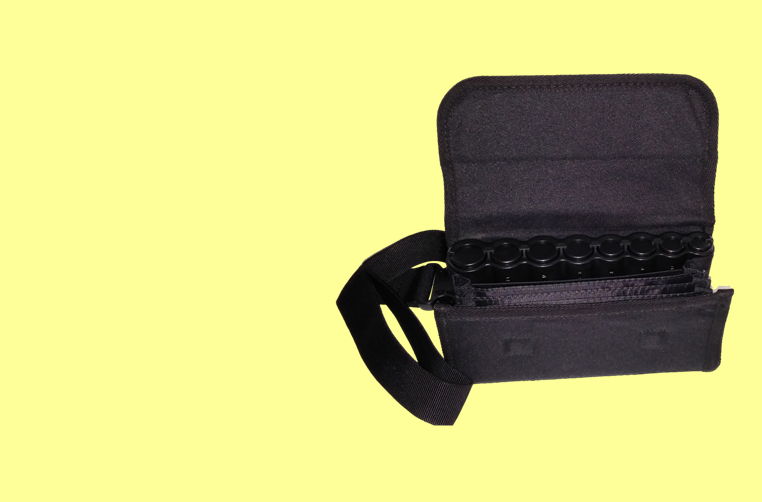Best Seller
Conta e verifica singola banconota Euro, Dollaro USA, Sterlina Inglese e Franco...
Caratteristiche
Organizza le tue monete euro in modo professionale con questi blister porta monete di alta qualità. I blister sono realizzati in plastica trasparente resistente e presentano una pratica fascia colorata per un rapido riconoscimento del taglio. Ideale per banche, attività commerciali e collezionisti che necessitano di un sistema efficiente per catalogare e trasportare monete. Include un pratico mastrino per annotare gli incassi e facilitare il conteggio delle monete.
I nostri speciali blister per monete

per avere sottomano
i conteggio delle monete versate
Tuo in omaggio
I am text block. Click edit button to change this text. Lorem ipsum dolor sit amet, consectetur adipiscing elit. Ut elit tellus, luctus nec ullamcorper mattis, pulvinar dapibus leo.
Macchine verifica banonote e contamonete
Conta e verifica singola banconota Euro, Dollaro USA, Sterlina Inglese e Franco...
PiCCOLE NOTIZIE SULL’EURO
QUANDO È NATO L’EURO?
L’euro ha sostituito le valute nazionali nelle tasche dei cittadini il 1 gennaio 2002, ma è stato introdotto ufficialmente tre anni prima, il 1 gennaio del 1999. Nei primi 3 anni dalla sua adozione è stata una moneta virtuale, utilizzata solo per fini contabili e nei pagamenti elettronici.
CHI AMMINISTRA L’EURO?
L’euro è amministrato dalla Banca Centrale Europea (BCE), l’ente che decide le politiche monetarie dei paese membri dell’Unione e dall’Eurosystem, l’organo composto dalle Banche Centrali dei paesi dell’Eurozona: Austria, Belgio, Cipro, Estonia, Finlandia, Francia, Germania, Grecia, Irlanda, Italia, Lettonia, Lituania, Lussemburgo, Malta, Paesi Bassi, Portogallo, Slovacchia, Slovenia, Spagna.
CHI STAMPA FISICAMENTE GLI EURO?
La BCE decide ogni anno la quantità monete che deve essere coniata, con l’obiettivo di garantire la corretta circolazione del contante e sostituire quelle eccessivamente usurate. La maggior parte delle banconote viene stampata dalle zecche degli stati membri dell’Unione o da stampatori privati.
Attualmente quelli autorizzati a produrre le banconote sono 17 e alcuni hanno sede in paesi come il Regno Unito e la Danimarca che non hanno mai fatto parte dell’Unione Monetaria.
QUANTE SONO LE BANCONOTE E LE MONETE IN CIRCOLAZIONE?
Secondo i dati pubblicati dalla BCE, alla fine di dicembre 2018 le euro banconote in circolazione erano 22.614.824.598 e le monete 130.717.264.347.
DI CHE COSA SONO FATTI GLI EURO?
Le euro banconote sono fatte in carta di puro cotone che le rende particolarmente resistenti all’usura. Una parte della banconota è stampata in rilievo così da permetterne il riconoscimento al tatto.
DA DOVE ARRIVA IL SIMBOLO DELL’EURO €?
Il simbolo dell’euro è si ispira alla lettera greca epsilon ε ed è un omaggio alla Grecia in quanto culla della civiltà occidentale ed europea. Le due linee parallele che attraversano il glifo indicano la stabilità della valuta comunitaria.
Il simbolo è stato presentato per la prima volta dalla Commissione Europea il 12 dicembre del 1996 ed è stato scelto tra 10 progetti originali. Il nome dell’ideatore del simbolo € non è mai stato reso noto ufficialmente, anche se si ritiene sia il tedesco Arthur Eisenmenger.
SMALL NEWS ON THE EURO
WHEN THE EURO BORN?
The euro replaced national currencies in the pockets of citizens on January 1, 2002, but was officially introduced three years earlier, January 1, 1999. In the first 3 years of its adoption it was a virtual currency, used only for accounting purposes and in electronic payments.
WHO ADMINISTERS THE EURO?
The euro is administered by the European Central Bank (ECB), the body that decides the monetary policies of the member countries of the Union and by the Eurosystem, the body composed of the Central Banks of the Eurozone countries: Austria, Belgium, Cyprus , Estonia, Finland, France, Germany, Greece, Ireland, Italy, Latvia, Lithuania, Luxembourg, Malta, the Netherlands, Portugal, Slovakia, Slovenia, Spain.
WHO PRINT PHYSICALLY THE EURO?
The ECB decides each year the quantity of banknotes and coins that must be minted, with the aim of guaranteeing the correct circulation of cash and replacing those that are excessively worn. Most banknotes are printed by mints of EU member states or private printers.
Currently, the number authorized to produce banknotes is 17 and some are based in countries such as the United Kingdom and Denmark which have never been part of the Monetary Union.
HOW MANY ARE THE BANKNOTES AND THE COINS IN CIRCULATION?
According to data published by the ECB, at the end of December 2018 the euro banknotes in circulation were 22,614,824,598 and the coins 130.717.264.347.
WHAT ARE THE EUROS MADE?
The euro banknotes are made of pure cotton paper which makes them particularly resistant to wear. A part of the banknote is printed in relief so as to allow its recognition by touch.
WHERE DOES THE EURO € SYMBOL ARRIVE?
The symbol of the euro is inspired by the Greek letter epsilon ε and is a tribute to Greece as the cradle of Western and European civilization. The two parallel lines crossing the glyph indicate the stability of the community currency.
The symbol was presented for the first time by the European Commission on 12 December 1996 and was chosen from 10 original projects. The name of the creator of the € symbol has never been officially disclosed, although it is believed to be the German Arthur Eisenmenger.

































